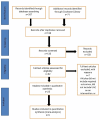Uterine artery embolization versus myomectomy: a systematic review and meta-analysis
- PMID: 38751568
- PMCID: PMC11095175
- DOI: 10.1177/20503121241236141
Uterine artery embolization versus myomectomy: a systematic review and meta-analysis
Abstract
Introduction: Uterine fibroids are the commonest benign tumors of the reproductive tract in women of childbearing age. They are usually asymptomatic but can cause menorrhagia. Treatments include myomectomy and uterine artery embolization (UAE). The latter is a relatively new procedure, therefore of special interest.
Objectives: We conducted a systematic review and meta-analysis of all published studies to provide a comprehensive outlook on the effectiveness of UAE by comparing its outcomes to those of myomectomy. Electronic databases (PubMed and Cochrane Central) were systematically searched from January 2000 to March 2022 for published randomized control trials, observational studies, and meta-analyses that compared UAE to myomectomy for at least one of the pre-specified outcomes, namely re-intervention rates, length of hospital stay, and complications.
Methods: We shortlisted nine studies for the final analysis. For continuous outcomes, results from random-effects meta-analysis were presented as mean differences (MDs) and corresponding 95% confidence intervals (CIs). Risk ratios (RRs) for dichotomous outcomes were pooled using a random-effects model.
Results: The final analysis consisted of nine studies. Factors like re-intervention, hospitalization, and complications, each with its unique follow-up duration were assessed. Pooled analysis demonstrated significant results for greater re-intervention rates with UAE as compared to myomectomy (RR: 2.16, 95% CI: (1.27-3.66), p-value 0.004, heterogeneity I2 = 85%). UAE holds a greater but statistically insignificant risk for major complications (RR: 0.62, 95% CI: (0.29-1.33), p-value 0.22, heterogeneity I2 = 0%) and myomectomy shows a statistically insignificant greater risk for minor complications (RR: 1.72, 95% CI: (0.92-3.22), p-value 0.09, heterogeneity I2 = 0%). UAE had a shorter but statistically insignificant duration of hospital stay (MD: -1.12, 95% CI: (-2.50 to 0.27), p-value 0.11, heterogeneity I2 = 96%) (p-value for subgroup differences = 0.005).
Conclusion: Our meta-analysis of approximately 196,595 patients demonstrates that myomectomy results in a significant reduction in re-intervention rate compared to UAE.
Keywords: Uterine fibroids; leiomyomas; myomectomy; uterine artery embolization.
© The Author(s) 2024.
Conflict of interest statement
The author(s) declared no potential conflicts of interest with respect to the research, authorship, and/or publication of this article.
Figures
References
-
- Mayo Clinic Staff. Uterine fibroids – symptoms and causes, https://www.mayoclinic.org/diseases-conditions/uterine-fibroids/symptoms...(2021, accessed September 2022).
-
- Professional CC Medical. Uterine fibroids: symptoms, causes, risk factors & treatment, https://my.clevelandclinic.org/health/diseases/9130-uterine-fibroids (2020, accessed September 2022).
-
- Barjon K, Mikhail LN. Uterine leiomyomata. In: Treasure island, Florida, United States: StatPearls, 2022, 2–4.
-
- Lohle PNM, Higué D, Herbreteau D. Uterine artery embolisation in women with symptomatic uterine fibroids. Presse Med 2019; 48(4): 440–446. - PubMed
-
- Medline Plus. Uterine artery embolization, https://medlineplus.gov/ency/article/007384.htm(2020, accessed September 2022).
Publication types
LinkOut - more resources
Full Text Sources
Research Materials
Miscellaneous






